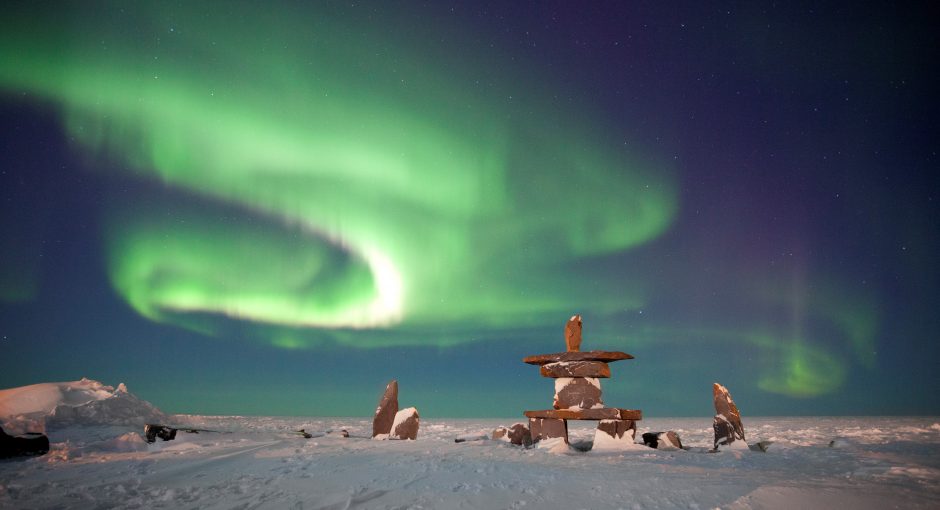
What is the “right” kind of camera for photographing the northern lights?
If you plan on traveling to a place for optimal viewing of the Northern Lights and plan to photograph them (I’m quite partial to Churchill, Canada), you’ll need to think about your camera equipment, as not all cameras have the capabilities to photograph the aurora.
Your Camera’s Capabilities
While actually getting the photo can be a little complicated (and I’ve outlined proper techniques HERE), determining if your camera can photograph them isn’t difficult at all. While having a good quality lens is helpful, that’s usually not the limiting factor. Instead, it’s your camera’s ability to shoot at long exposures while at a high ISO.
As a photo guide for Northern Lights Photo Expeditions, I’ve unfortunately seen some guests come with cameras that could shoot at long exposures, up to 30 seconds, and they could also get to high ISOs, 1600, and even 3200. However, the camera could not do both at the same time. This is a deal breaker!
Be sure to do some test shots at home (and at night) when evaluating whether you’re camera’s cut out for the job.
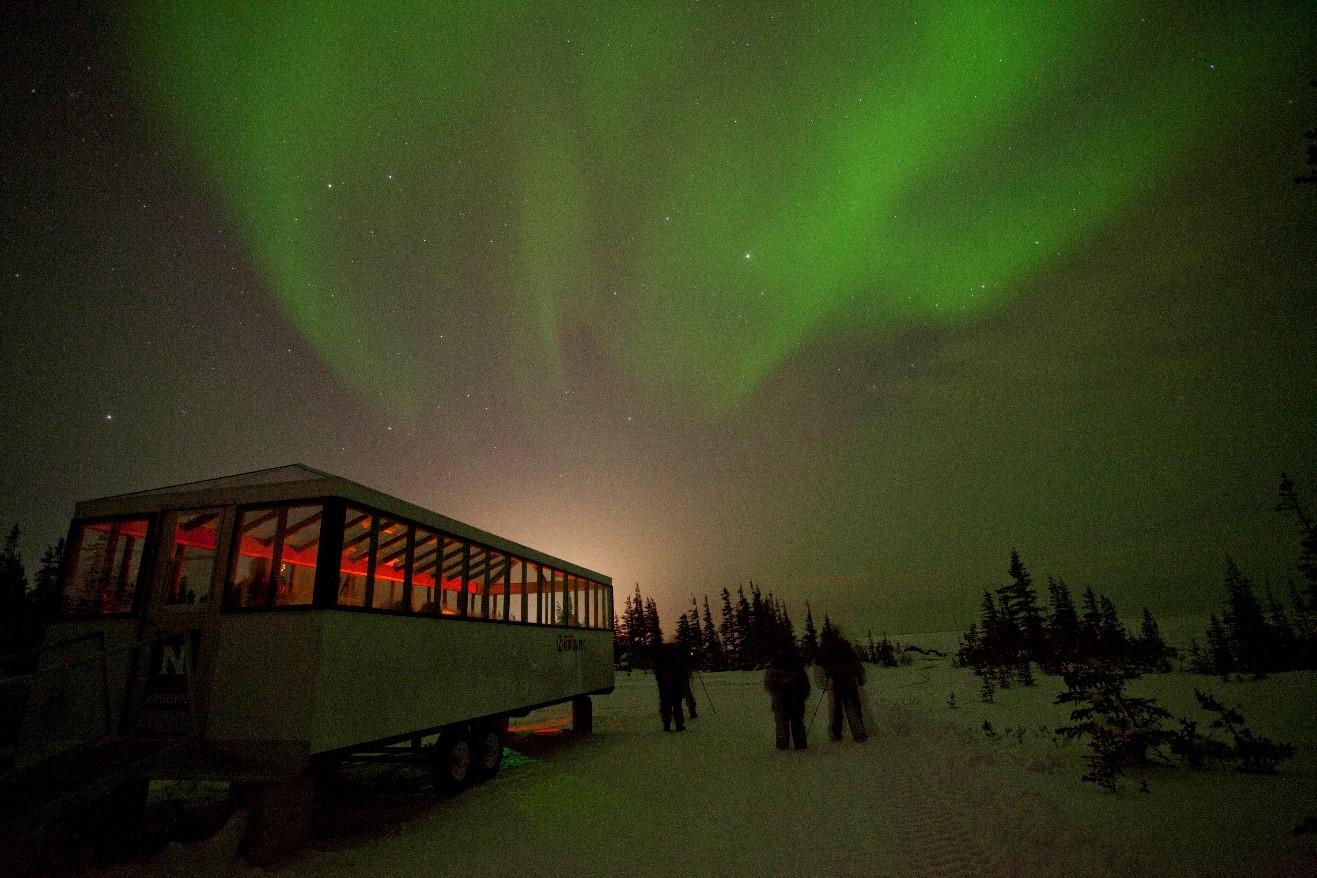
Deciding on the Right Lens
If you do have a point and shoot, and it’s passed the test from the above section – you’re all set! No need to think much further. However, if you have a camera with interchangeable lenses (or you’re thinking about upgrading to one), this section is important for which lens is right for the job.
Generally speaking, you should prioritize the angle of the lens vs. the speed of the lens. You’ll often hear people saying that you need a fast lens…that is, one with a very wide maximum aperture, like f/2.8 or even f/1.4. While this is helpful in getting the best photos possible, you don’t want to favor those apertures if it means you have to go with a 50mm or 85mm lens. These just aren’t wide enough to get the full sky, let alone neat things in the foreground to give the shot context (like an igloo or inukshuk or people).
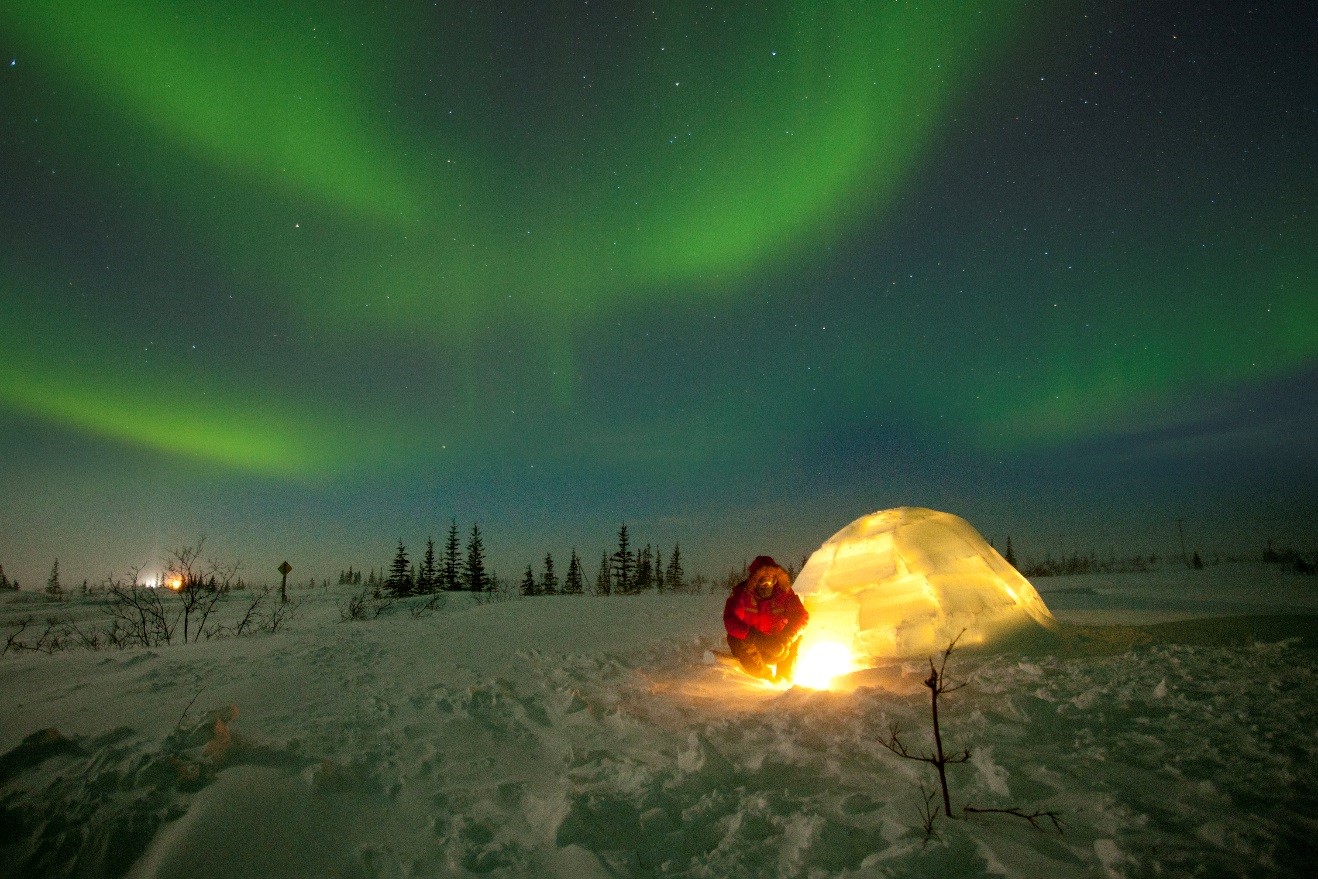
Thus, if you’re faced with the decision between a “normal” wide angle lens, like an 18-55mm f/3.5-5.6 vs. a 50mm 1.4, you really ought to go with the 18-55mm. You need to have the ability to get a lot of the scene in your photo. A 50mm version of the same shot as above looks like this…
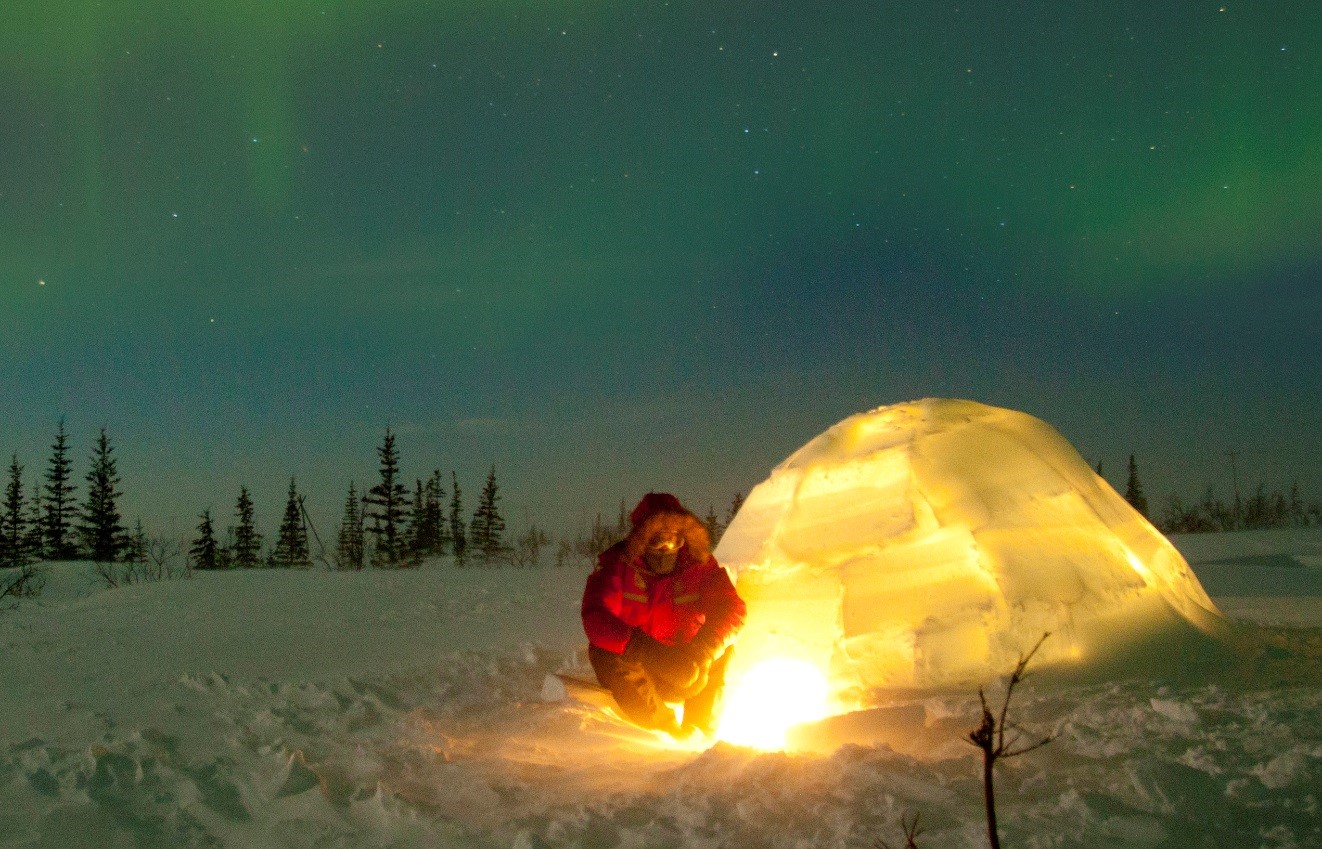
It just simple doesn’t have the same effect, does it?
So, if you have an assortment of lenses, I personally recommend you bring the widest lens you have as your #1 pick.
However, if you’re planning on purchasing a lens specifically for photographing the lights, here are a few recommendations. Keep in mind that they can get pricey, because the technology inside them to “have your cake and eat it too” is pretty advanced…
My top picks: 24mm f/1.4; 16-35mm f/2.8; 14-24mm f/2.8; 14mm f/2.8; 17-40mm f/4; 18-55mm f/3.5-5.6; 24-70mm f/2.8; 24-105mm f/4
The “best” camera
To start, let me just say that virtually any DSLR or mirrorless camera body is great, and you’ll likely come home with stunning shots. However, if you really want to know the best, and shoot with the best, you ought to think about investing in a full frame camera. They are indeed an investment, but they are specialists at photographing in dim or dark conditions. They have a larger sensor, which means you can get dramatically better shots in very suboptimal lighting conditions.
If you’re not sure you’re ready to invest in a fancy camera body, read no further, as these are usually well over a $1,000 commitment. However, if you have a budget to get the best, I recommend getting a full frame camera. If you’re interested in learning more about different camera bodies, including full frame cameras, read my article about full frame cameras HERE.
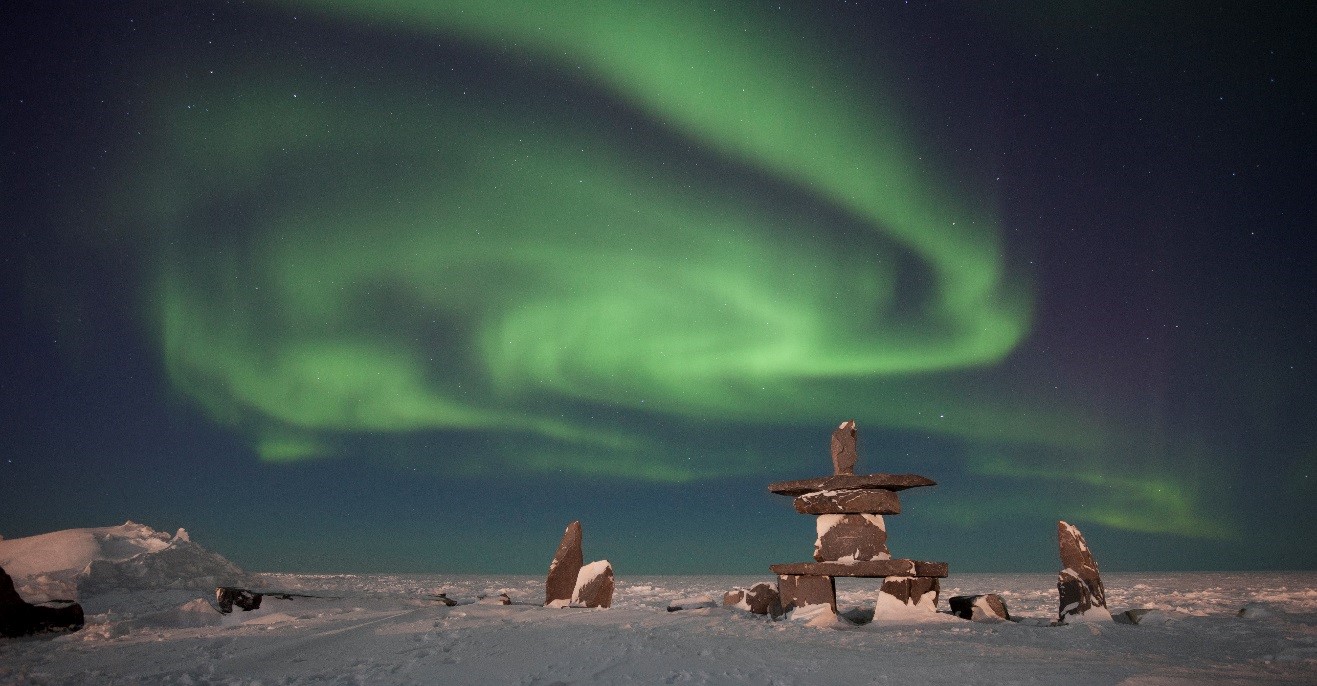
In Conclusion
There are many ways and many combinations of camera bodies, lenses, and advanced point and shoots that will work for capturing the northern lights. If you are opting for an all-in-one system, like an advanced point and shoot camera, be sure to test it to make sure it can shoot at long exposures and high ISOs. If you are picking out a lens, make sure it’s very wide angle then choose based on the fastest speed (aka, smallest f/number)…not the other way around. If you’re aiming to upgrade your camera system, want the very best, and price is no issue – go for the splurge and get a full frame camera.
Hope this helps, and feel free to ask specific questions in the comments below.
Cheers!
Court
44 Comments

Donald Snyman
August 8, 2017 at 11:10 am

Tina
February 3, 2018 at 9:44 am

Court Whelan, Ph.D.
February 19, 2018 at 10:54 am

Yessica
May 14, 2018 at 1:18 am

Court Whelan, Ph.D.
May 14, 2018 at 3:14 pm

Yessica
May 30, 2018 at 9:53 pm

Steven
February 15, 2018 at 4:40 pm

Court Whelan, Ph.D.
February 19, 2018 at 10:57 am

Karen
October 17, 2018 at 6:32 pm

Court Whelan, Ph.D.
October 25, 2018 at 8:21 am

Thomas Allen
October 31, 2018 at 7:54 am

Court Whelan, Ph.D.
November 5, 2018 at 11:45 am

Jim Messervy
December 14, 2018 at 2:29 pm

Court Whelan, Ph.D.
February 3, 2019 at 1:52 pm

Jim Messervy
December 18, 2018 at 9:37 am

Court Whelan, Ph.D.
February 3, 2019 at 1:50 pm

Minal Mehta
January 4, 2019 at 6:14 pm

Court Whelan, Ph.D.
February 3, 2019 at 1:47 pm

John Emmel
January 11, 2019 at 1:45 am

Court Whelan, Ph.D.
February 3, 2019 at 1:45 pm

Erik Simić
April 17, 2019 at 2:09 pm

Court Whelan, Ph.D.
April 30, 2019 at 11:59 am

James Sloop
May 11, 2019 at 3:41 pm

Court Whelan, Ph.D.
May 23, 2019 at 8:22 am

James
September 1, 2019 at 6:43 am

Court Whelan, Ph.D.
September 1, 2019 at 10:04 am

Oscar
November 15, 2019 at 4:22 am

Court Whelan, Ph.D.
November 21, 2019 at 2:08 pm

Rimzim
November 18, 2019 at 5:48 am

Court Whelan, Ph.D.
November 21, 2019 at 2:05 pm

James
January 19, 2020 at 4:16 pm

Court Whelan, Ph.D.
January 23, 2020 at 10:19 am

Bruce
August 3, 2020 at 10:55 am

Court Whelan, Ph.D.
August 5, 2020 at 8:21 am

Su
November 27, 2020 at 12:10 pm

Court Whelan, Ph.D.
December 6, 2020 at 8:36 am

james sloop
March 15, 2021 at 12:13 pm

Court Whelan, Ph.D.
March 24, 2021 at 1:15 pm

Chengje wayan
April 26, 2021 at 1:27 pm

Court Whelan, Ph.D.
May 5, 2021 at 1:41 pm

Nataly Hernandez
July 30, 2021 at 6:29 am

Court Whelan, Ph.D.
August 6, 2021 at 12:34 pm

Tim G
February 17, 2022 at 8:35 pm

Court Whelan, Ph.D.
February 21, 2022 at 9:46 am
Beautiful pictures something to look forward to when I get up there.
Hi. We’re going to Iceland in March and wants to be able to take pictures of the northern light, waterfall and the ice caves. Which camera would you recommend for this? We do have a budget of under $1000. Thank you for your time. Tina
Hi Tina! Great question. I would personally recommend a Canon Rebel, with an 18-55mm lens. There are a number of Rebels out there, as they come out with a new version each year. There are major improvements in sensor quality and ISO sensitivity in recent models, so I would aim for the T6i or T7i if it’s within your budget. Hope this helps!
Hi, if I get the camera that you recommend above, to catch the northern light do we need to buy another lense or just with this camera is enough?
Hi Yessica, the camera is usually enough, but as you can imagine, there is almost no limit to how fancy you can get, when it comes to additional equipment. If you do get a DSLR, with interchangeable lenses, the “kit” lens, that usually comes with the camera package, should be fine. But, if you want to upgrade, ultra wide angle lenses and “fast” lenses (f/2.8 or lower) will give you maximum versatility and quality. Hope this helps!
Thank you for the reply it really helps!
Court I was told that if you have a digital camera and the temperatures are below freezing the camera will not work due to the electronics freezing up. I would like to know if this is true. I’m planning on taking a trip up there next year.
Hi Steven! Hmmm, this hasn’t happened to me before, and I’ve really pushed my camera, being out in -40F for a while at a time. I suppose this could be a factor of cost, as I’m using a fairly fancy Canon camera. Perhaps less costly point-and-shoot cameras have this vulnerability? Frankly, I don’t think they do, though. I think the main risk is that batteries drain somewhat quickly, such that you may use 2 or even 3 in a single day in really cold temps. But, I’ve not seen the whole system freeze up before. Hope this helps!
What are your thoughts on this camera for aurora? The full frame camera bodies start at $2000 from what I Found. This one is $1500. I live in Juneau.
Sony – Alpha a6500 Mirrorless Camera with E 18-135mm f/3.5-5.6 OSS Lens – Black
Thank you for your article!
yes indeed! I’ve heard great things about the Sony Alpha series, and this one is a pretty good deal. This isn’t full frame, from what I understand, but you definitely don’t need a full frame to get great aurora shots. It helps, but is only a bonus…any camera this advanced is still going to get wonderful shots. As far as the lens, that’s a good one to start with. Then, once you catch the shutter bug, you may wish to get something a bit more dedicated to aurora, with a lower f/number and a bit less range (in my opinion, lenses with big ranges tend to sacrifice a bit in quality). But again, great intro lens! Hope this helps!
What about video? I see many, many comments on the camera and types of cameras, but I hardly see any on video cameras. Is recommended not to try and capture the Northern Lights via video and just use a camera? If not, can you recommended what is the best video camera?
A great question! And it would certainly be cool! However, it’s basically impossible because each video frame would need to be 5 to 10 second exposures. Thus, to cram in 24 to 30 frames a second (which is what video typically is), you just can’t. Typically when shooting video 1/24th of 1/30th of a second is all you can do because again, all those frames have to fit within one second.
What you CAN do, though, which is what you’ll see on videos like on youtube, vimeo, discovery channel, etc. Is to take a time lapse video. This technique is where you set your camera of a function to continuously take photos, say, over the course of an hour, at specific frame rates. So in this case what I’d do is set my camera to take 2 hours of photos, one photo ever 10 seconds, and each photo a 10 second exposure. Then, over the course of the 2 hours, I’ll have hundreds of photos, which I can merge into a single video file (using software) to get a time-lapse video of the aurora. If you are keen to learn more on this, there are some great internet resources and it’s great fun! But, it take a lot of time, and frankly I’d prefer to be taking still photos that whole time rather than having my camera busy with one single time-lapse video the whole night.
Hope this makes sense and GREAT question!
Hello. We’re gearing up for our Northern Lights tour in Feb [2019], and could use your opinion. We have a “kit” lens, EFS 18-55mm f/ 3.5-5.6 [for our trusty Rebel T1i] and would like to get a wide angle lens. Do you have any feelings on fixed focal length vs. non fixed wide angle lens selection?
Hi Jim,
Actually the kit lens that comes with these cameras is quite alright. The 18mm at f/3.5 gets the job done. Frankly, if I were to invest in any gear in your shoes, I’d try and upgrade the camera body slightly. The T1i is good, but it’s got older technology to it and doesn’t have good low light sensitivity. That is, when shooting at anything over ISO 800 it gets quite grainy. Thus, getting a newer rebel, even one a few years old, will pay big dividends. And then I’d just use the 18-55mm with that newer Rebel. I think they’re up to a T7i by now, but you can save a little money by getting a T5i or T6i and it’ll still be lightyears better in low light vs. the T1. Hope this helps!
Hello. Am going to Churchill in Feb. 2019, and am looking for wide angle lens for my Rebel EOS T1i. Any thoughts regarding “prime” vs. zoom lens?
Hi Jim,
You bet! I think my top pick would be Canon’s 10-22mm lens. Although it’s not a particularly “fast” lens, at f/3.5-4.5, you generally don’t need something crazy fast for northern lights. However, if you’re going to go for a prime lens, I’d recommend looking at Rokinon lenses, as they are both fast and affordable at very wide angles. To me, I do feel like having a bit of zoom is nice, to help frame the photo, but my general advice is to pick a lens that’s very wide first (thus the 10-22) and worry about the aperture later. That is, if you’re comparing two 10-22 lenses, go for the faster one, as long as it doesn’t break the bank. I wouldn’t go for anything slower than f/4, but f/4 gets the job done nicely.
Hi,
I need to buy a camera for northern lights .. traveling in the 15th January 2019
So pls recommend a good camera with what lense to buy ?
Awaiting your reply ..
Thanks Minal Mehta
My email is miinall@yahoo.com
Hi Minal! It’s a complicated question, as there are so so many options. And those are based on many factors like past experience, budget, plans for the future, and threshold for specialty equipment. However, please do write back if you have specific parameters that I can help with. Most notably what equipment you already have and what your budget might be.
Thanks for the very informative articles!
I’m planning to rent a Sony a7 iii camera & lenses for an upcoming northern lights trip, and wondering which wide-angle lens you’d recommend given a choice between (Sigma) 14mm f/1.8 or 20mm f/1.4? I plan to rent a 24-240 zoom too. It is possible 14mm might be too wide for aurora photos?
Hi John,
I’ve heard great things about the Sony A series! I think you’ll love it. In my humble opinion, I would go for the widest lens you can, even if it’s not as big of an aperture. Thus, I’m thinking the 14mm f/1.8. And as far as too wide, nope, no such thing for aurora. You can always crop in if necessary, but generally the more sky you can get in your frame the better.
Hello
I zravel a lot to different country and I visit many beautiful places.
I have a very old cameras that takes very bad photo for my opinion so I am also taking pictures with my Phone.
So I Know that pictures with ceras are bett er pictures so I am asking what camera do you suggest.
(now I am looking at NIKON D5300)
Nikons are great cameras, and the D5300 is a perfect starter DSLR. There are of course many, many options, and it’s always important to keep in mind that you get what you pay for. The next big step in cameras is once you go from a “crop frame” to a “full frame” camera. Although expensive, they’re very useful for shooting in low light conditions, like aurora or star photography.
planning a trip to Alaska to see the lights. Iam setting my budget at
$1000 for camera and lens what do you recommend.Thanks.
For that budget, you can either go for a Canon Rebel + 18-55mm lens and a 70-300mm lens, but you may be a little limited on telephoto at 300mm. Instead, maybe I’ll suggest that you look at either the Sony RX10 III, or the Canon sx70hs. The canon is more around $500 and the Sony is more around $1,200, so not perfectly on the money, but pretty darn close! I vouch for both of these, and they are cameras that you don’t need any extra lenses for :).
just seen the canon sx70,look nice
your price range was spot on. Don’t know much about hi tech cameras but I believe this is a perfect to start out with. what is the downside to the camera if any
it’s indeed a great camera! For that type of camera and price range (advanced point and shoot, $550-$600) there are virtually no downsides! But in full disclosure, compared to a fancy DSLR or mirrorless camera at 2x or 4x the price, you’ll notice a difference in low light sensitivity as well as overall quality of the shot. Basically, the more you spend and the more gear you lug around with you (extra lenses to change, etc.) the higher resolution your photos are. HOWEVER at this price, size, and ease-of-use, the sx70 is amazing.
Hope this helps!
Hi Court,
I am going to Iceland next month and I am interested in getting a camera for this trip. I am a beginner (not experience at all with cameras) and was interested in buying a Bridge camera for this trip ( something like the CANON PowerShot SX540 HS). Would a camera like this help me capture nice pictures of the northern lights or am I asking too much? Do you have a camera suggestion in this budget (around $ 250-350 ). Thanks!!
while a bridge camera like this will be fantastic for 99% of all photography, it likely won’t do the trick for northern lights photos. Wish I could say “yes, it’ll do great!” but I’ve seen these in action, and they just don’t have a long enough exposure at a high enough ISO. Frankly, aurora photography is VERY challenging for the camera, so you must have something more in the mirrorless or DSLR level. One way you can tell if your camera will work is if you can set it on manual, get a f/number somewhere around f/4, a 20 second exposure AND an ISO around 1600 or 2000. Most point and shoots, even if advanced, unfortunately just don’t have the tech to make that work. Hope this helps a little!
Hi Court. I’m not new to cameras but honestly, all the tech talks go over my head.
Would this be a good option?
Nikon – D5600 DSLR Two Lens Kit with 18-55mm and 70-300mm Lenses – Black
Thank you,
Rimzim
yes indeed! This is a great setup, and covers a great range of telephoto/zoom. The 18-55mm will be your “go to” lens for photographing the aurora, and general travel shots of “the north” at this time of year. The 70-300 will be great for anything you need at a distance, which frankly won’t be all that much in Churchill during the winter, but will be a go to lens for any other classic wildlife safari. Hope this helps!
purchased the Nikon 5600 what lens would you recommend for shooting the Northern lights, thanks.
Hi James, great question, but a loaded question! There are SO many great lenses out there, and they come from many manufacturers, and at many price points. Generally, I recommend getting a lens in this order of priority…a lens that is a) very wide (10, 12, 14mm at widest) b) is fast (f/4, f/2.8 or faster) and c) is of good quality. Weird how I say good quality last, right? Mainly that’s because you can get some very good “b+” lenses that are wide and fast, but may not be the top tier Nikon glass. Companies like Rokinon, Tokina, tamron and others fit this bill. There is a great Nikon 14-24mm f/2.8 that is wonderful for aurora photography, but this is nearly $2,000. Alternatively, a Tokina 11-16 f/2.8 is about $500. And it’s actually WIDER! Thus, I’d go for the Tokina in most cases – https://www.adorama.com/tn1120dxnkd.html?utm_source=rflaid913479
Hope this helps!
Hi
Northern Lights north of the Artic Circle beckon at Christmas 2020 (subject to covid), so am preparing now. I think the Canon EOS 90D is the body. I can pick up a bundle with a Canon EF S 18-50mm f/3.5-5.6 IS STM and another longer Canon lens (55mm-250mm) at a reasonable price for other amateur outside work. The question I have is really whether this identified supplied 18-55 lens is good enough? I was looking to perhaps get the Canon EF 17-40 f/4L USM (literature says it’s EF16-35 with f/2.8) lens bit is this really worth the additional US$500 investment or will the supplier be good enough for, atmospheric permitting, stunning photographs.
Hi Bruce, great question! Personally I think the 18-55mm would be enough. If you do wish to get a better/more ideal lens for your canon, I would recommend the 10-22mm they make. The 17-40 will be better quality than the 18-55, but it’s a very very similar range. The 10-22mm will also be better quality (i.e., better glass, sharper photos, etc.), but it adds a really important wider field of view, which I personally feel is extremely helpful for aurora photos–more sky, more foreground, more aurora. You’ll probably find that you like it for a lot of other photography, too. So, I do recommend picking up the 10-22mm if you can swing it, but at the end of the day the 18-55 will work and you’ll still get great shots.
Hi Court
hope you are stil answering questions. I have been looking through camera info for a while now and just find it quite overwhelming.
I would really like a lighter (weight)camera because dragging camera’s round in the middel of the night usually just gives me next to great photo’s a load of pain in the neck/shoulders. But of course I realise that it’s a choice that has to be made. So am looking for a good replacement for my old Nikon (D400) or my really old Canon Rebel(needs putting out to rest 🙂
Am willing to invest between 2-3000 €
Hope you can give some good tips for camera body and best lens (also for use outside of arctic conditions) Live in Netherlands but love visiting Northern Norway, seden, finland (hope one day to get up the somewhere like Fairbanks or Churchill.
Thanks for any help you can give
Su
Hi Su, good to hear from you! This is a good question, but of course with many ways to answer! In my mind, you can go one of two directions. If you are still ok with the interchangeable lens world, which is going to give you better quality, but generally more to deal with (and ensuing size and weight) I might recommend looking at Olympus…they have a great system that is known as “micro 4/3s” and the smaller sensor enables the entire system to be much smaller than DSLRs and even other mirrorless systems. They’re great. However, I could also recommend you look at Sony’s “bridge” camera system, which takes away the interchangeable lens aspect. Thus, it’s one size that basically does it all. Their RX10 IV is a really solid camera that competes with the bigger fancier ones, too. The thing to think about when comparing these two is that the Olympus is going to be smaller if using small lenses, but will get slightly bigger than the Sony as soon as you start putting on the quality lenses. The Sony RX10 will be a little bigger and heavier than the Olympus+small lens, but won’t ever get bigger–and has a 600mm lens built right into it! Thus, you will know exactly what you’re getting into once you compare sizes and weights. I hope this helps a little! Let me know!
I have a nikon 5600 and I purchased a tokina
Atx-i 11-16mm f2.8 Niko f can you re commend a site on how to use it mainly for the northern lights thanks
Hi James, happy to help here. I’d recommend you check out my “Step by Step Plan for Photographing the Northern Lights” at this link and post: https://dailywildlifephoto.nathab.com/photography-guide/step-by-step-plan-for-photographing-the-northern-lights/ . I think it’s exactly what you’re looking for!
Hi..I had d3100 camera the lens is 18-55 and I want to change the lens any recommendation good for northenlights moon ,star etc….
Hi Change, the 18-55mm isn’t bad, but Nikon makes a great 10-24mm lens for the DX platform. But frankly, the biggest improvement you can make in your setup for low light photography would probably be to consider a full frame camera. It’s a much bigger investment than just a new lens, but I’d be remiss if I didn’t mention this, too. For now, though, getting an “ultra wide angle” lens is going to be your best bet…more angle equals more sky, more stars, and more aurora in your shot!
Hello Court,
Thanks for your article, I have been researching about budget-ish cameras for capturing the northern lights. Since I live in Finland I travel North at least once a year to try, but I have been usually relying on tours mostly to get high quality pics and posisbly with me on them too 😉 Anyway, point is I decided to have something on my own and a good intermediate approach was to get an older model of a camera (that is still good) , so I got a Sony A7S in excelent conditions, supposedly amazing with low light.
Now I´m looking for lenses…(will search also for used ones if too expensive) but if no restrictions what lenses woud you recommend for that? This IS intended for my northern lights trips almost exclusively and living here the tendency is to go up north again .
For everything else I´m very pleased with my Samsung phone and super zoom DSRL.. that´s why I was hesitant ($$) to invest but on the other hand I´m very much obsessed with the northern lights so I want my own pics and videos which I have undesrstood is to certain extent possible with A7S 😉
Thanks and regards,
Hi Nataly, thanks for the note here and I’m glad you’re getting out to photograph the aurora when possible! As far as lenses, there are two schools of thought. One would be to get a very “fast” lens, like f/1.4 or f/1.8 at 24mm (full frame equivalent). The other school of thought, which I’m partial to, is to get a very wide lens, like a 14 or 16mm full frame equivalent, and just get it as “fast” as possible…usually this means f/2.8 or even f/3.5. See the thing is that northern lights actually aren’t all that dim, contrary to astrophotography. Thus, I prefer going very, very wide to get as much of the sky and lights as possible, and just dealing with the slightly “slower” aspect of an f/2.8. It’s worked very well for me over the years, and I hope the same for you!
Hi Court!
I just wanted to state that this was an interesting article. I plan on photographing the aurora sometime soon, now that we have entered the solar max for the next few years. With that being said, I have all three iterations of the beastly Canon 1D X-series. Will these be sufficient for photographing the aurora with excellent results? I understand that these are used mostly for sports and wildlife, not landscapes, due to their somewhat limited MP count (18mp, 20.2mp and 20.1mp respectively).
What is your take on the 1D X, 1D X Mark II and 1D X Mark III for photographing auroras?
Hi Tim, great to hear from you and glad to hear you’ll be taking advantage of this solar maximum, as we are getting some incredible solar explosions, resulting in some mind-blowing aurora. The 1D series is plenty of camera for aurora :). I’d recommend using full frame settings (as I recall, some of these models offer a crop option, which is great for sports, and go for as wide of a lens as you’ve got. Don’t worry if it’s only f/3.5 or f/4–you can crank up your ISO a bit to 1600 or 3200 with good results. Enjoy it!!